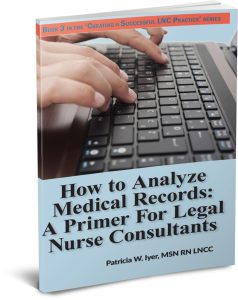Why Medical Records can be Defective
Medical records can be defective. We know that as legal nurse consultants.
The analysis of cases involving medical issues rests heavily on being able to extract meaningful information from medical records. Why are some electronic medical records inherently defective?
Medical record software program defects
One reason why medical records can be defective is an inadequate software program. While our healthcare system fosters the small group practice model, governmental initiatives may result in loss of independence that physicians value. Forced into adopting electronic health records, some physicians have fought back when they did not get what they paid for. A class action suit involved Allscripts, which produces a widely used software program geared to office practices. “MyWay” has been attacked as an expensive but defective software product (link to allscriptsmywayclassaction.com).
Instead of fixing the problems, the suit alleged the company took its product off the market, after accepting $40,000 per user from 5,000 physicians.
Physicians were offered a “free” transition to a related product that was not really free because of the investment in training needed to learn the new system. The new software is more elaborate than many doctors need.
Production pressure can cause medical records to be defective
Another reason for errors in the medical record is production pressure.
Production pressure is manifested in many areas of health care anywhere there is a need to enter notes into the medical record of a patient before moving onto the next person.
A handy shortcut is getting providers in trouble. Copy and paste is useful when creating Word documents but can be the source of errors when medical records are copied and pasted. It is tempting to healthcare providers to take shortcuts by copying and pasting the note they wrote the day before, or the note the previous shift wrote. This system has the potential to carry over outdated or inaccurate information. I’ve seen physician progress notes that repeat data that is clearly wrong.
A study published in Critical Care Medicine found that copying and pasting was common. This practice has drawn the wrath of the Department of Health and Human Services Office of the Inspector General. The OIG announced that it planned to review multiple electronic health records. The practice of copy and paste is sometimes called cloning. It could be associated with fraudulent coding and billing practices.
Not long ago a physician told me that he saw as many as 30 patients in a day. He used voice recognition software to dictate his notes, but this is key – he did not have time to read over what the computer produced for his office notes.
He kept his fingers crossed that the software had accurately transcribed his voice. I’ve had experience with using voice recognition software and proofreading the reports of our experts who use it. Nothing is 100% accurate. He candidly admitted he is haunted by the errors that may be present in his office notes.
 When you are reading medical records, take them with a grain of salt. Don’t always believe what you read. Well-meaning, but stressed healthcare providers take shortcuts. As a result, medical records can be defective.
When you are reading medical records, take them with a grain of salt. Don’t always believe what you read. Well-meaning, but stressed healthcare providers take shortcuts. As a result, medical records can be defective.
Pat Iyer MSN RN LNCC is founded Med League, an independent LNC business, and authored How to Analyze Medical Records, one of her best selling books here.

